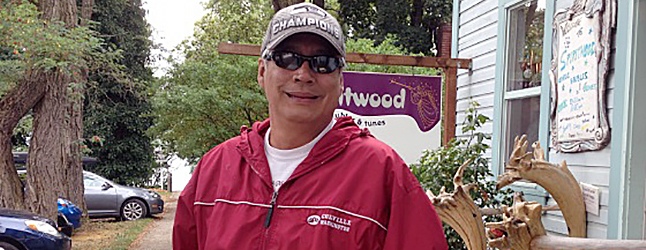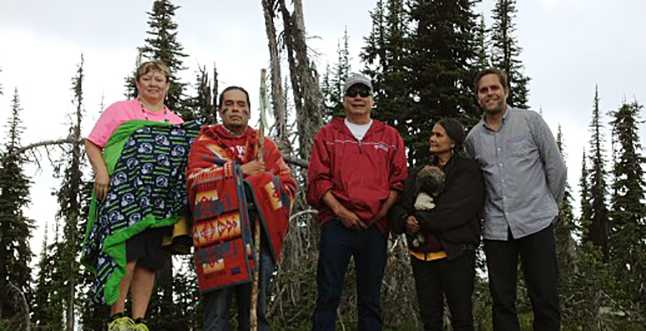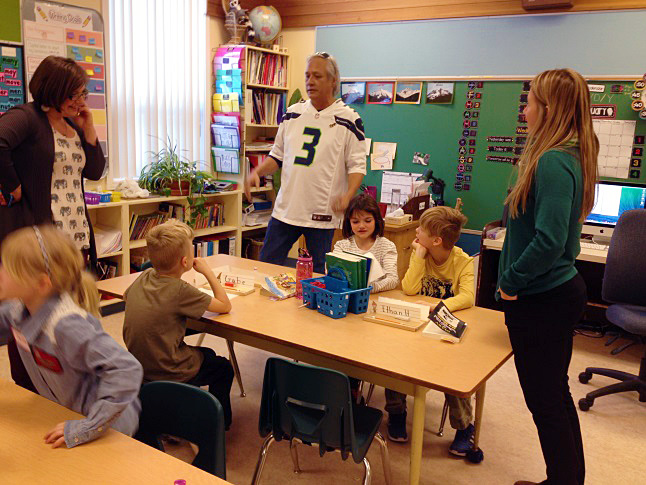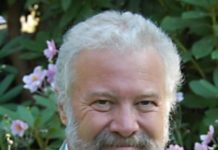
By Laura Stovel
On the afternoon of Sunday, June 13, people living all along the upper Columbia River lost a dear friend. Virgil Seymour – wise, generous, and loved by so many – left us only 2½ years after entering our lives.
“At least three years,” he would say. “I came up to Revelstoke in the summer of 2013 with my wife, Jana.”
“Ah, it’s true. That was when your connection with Revelstoke began. But we didn’t meet you until January 2014 and it’s really about us,” I teased him. And we laughed.
Virgil’s historical connection to the land
Teasing aside, we were both right. Virgil, as the Arrow Lakes Facilitator for the Confederated Tribes of the Colville Reservation in Washington State, has a spiritual and ancestral connection with Revelstoke. His people, the Sinixt, lived on the Columbia River between Kettle Falls and the land and river north of Revelstoke from time immemorial until they were both drawn and pushed south into the United States in the late 1800s and early 1900s. They wintered in the north part of their territory, hunting and fishing in the Revelstoke area, and at this time of the year, through the summer and early fall, they would be in the south, around Kettle Falls.
They were drawn south more permanently, beginning in 1825, with the construction of the Hudson’s Bay trading post, Fort Colville, just north of Colville, Washington, which provided new opportunities for trade. They were pushed south in the 1860s by miners, white settlers, and governing administrations in the Colony of British Columbia, and later Canada, that simply would not recognize their land rights.
The Oregon Treaty established the international boundary on the 49th parallel in 1846, dividing British and American territories. In 1872 the American government created a large reserve of 2,852,000 acres (11,540 square kilometers) for the joint use of 12 tribes that formed the Confederated Tribes of the Colville Reservation. Initially the reservation ran right up to the border and contained some Sinixt traditional territory. Many Sinixt settled at Kelly Hill, not far from the Canadian border. In 1891-92, the Colville tribes ‘ceded’ the northern half of the reservation and Kelly Hill was also lost. The reservation now covers 1.4 million acres or 5,666 square kilometers.

“Canada was not safe for us,” Virgil often said, even though most Sinixt territory was in this country. The Canadian government would not recognize Sinixt land rights and, only belatedly, created a very small reservation for the “Arrow Lakes Indian Band” at Oatscott on the Lower Arrow Lake in 1902. In a sense this worked as an administrative slight of hand, deliberate or not, which ultimately led to the disappearance of a whole tribe on the Canadian books.
(Even today, bizarrely, Parks Canada employees are forbidden from publicly mentioning the Sinixt. The plaque at the Monashee Lookout on Mount Revelstoke which discusses aboriginal land use does not mention them, even though they were the main group on this land at the time of contact. Incredibly, Parks Canada employees cannot even mention that the Sinixt were here historically, even though it would seem that something that was extinct – if they were – could still be named. Parks Canada does talk about dinosaurs).
Few Sinixt settled on the small Arrow Lakes reserve, which was completely inadequate for their rights, lifestyle and needs. As Alex Christie, a famous Sinixt man, said simply in 1915, “The reason I didn’t live (at Oatscott) is it was not my home.” Sinixt people moved south into the much larger Colville Reservation in Washington or intermarried into neighbouring nations.
After the last resident on the reserve, Annie Joseph, died in 1953, the federal government declared the Arrow Lakes Band to be extinct and the reserve land was given to the province. As historian Eileen Delehante Pearkes wrote, “At that time, 257 ‘Lakes Indians’ were enrolled with the Colville Confederated Tribes of Washington State. Even more may have been living off-reserve and simply not been counted.”
A master at building relationships
Yes, Virgil was right. His relationship with Revelstoke started three years ago and long before that. But I was right too. It was about us, and the relationships that he built in just 2 ½ years. It seems remarkable that we met Virgil only in January 2014. I hosted a potluck for him and invited members of the School District’s Aboriginal Education Committee – chair Michelle Cole and aboriginal student assistants Lisa Moore and Michelle Kuster – who presented him with a tobacco leaf grown locally by Peter Oosterhoff.
Right from that first meeting, Virgil was thinking of ways to help us – which always amazed me because I feel we owe a tremendous debt to the Sinixt who knew and kept this land so well and whose lives were altered so drastically by our presence.
He did have goals though. He wanted the Sinixt to be recognized at the informal and formal (governmental) levels as having been the main occupants of this valley historically. He wanted to be able to claim and repatriate ancestral bones, and he wanted all the nations who claim this area to collaborate for the benefit of the river, the salmon and the natural surroundings. He felt that the Canadian government was dividing First Nations where they should be working together.
On Virgil’s next trip to Revelstoke in May 2014 he met with Cathy English, curator of the Revelstoke Museum and Archives, and offered to lend his grandfather’s vest for a Sinixt exhibit (which will open next week, on June 21, and which he never got to see). He brought Cathy his grandfather’s chaptik stories – an audiofile of his grandfather Peter J. Seymour telling them in the Sinixt language, nsyilxcen (an Interior Salish language shared with the Okanagan), and recordings of children speaking the language.
Virgil’s approach was never, “What can you do for me?” but rather, “What can I do for you?” For that, people up the valley, including me, would go to great lengths to make his dreams happen. I became his volunteer ‘Revelstoke secretary,’ booking rooms, making introductions and always holding a potluck in his honour whenever he came into town, to connect him with friends and introduce him to new people. The conversations flowed and many ideas and possible collaborations were sparked at those dinners.
During Virgil’s first visit, I took him to the Tonklawatka (Tum Tum) Creek in the Big Eddy because we know, from museum and other records, that that area was important for the Sinixt. While we were there, he told me that he would like to bring youth from the reservation up here, he taught me the word for friend in nsyilxcen, and then I left him by the creek to pray.
Over the coming months and years Virgil drove up to Revelstoke many times – a more-than six-hour journey from his home in White Lake, near Inchelium, WA. He introduced us to two remarkable men, Adam Wicks-Arshack and Xander Demetrios, who canoed up the Columbia River in dug-out canoes they made themselves, with the help of many school children, and produced a film about it (which can be viewed at http://www.celp.org/programs/crt/treaty-talks/ ). They did this to raise awareness of the impact of the dams on the Columbia on the salmon and the possibility of bringing them back.
Last year, Adam and Xander returned to Revelstoke with D.R. Michel, Executive Director of the Upper Columbia United Tribes, to show the film and share a way to bring salmon over the dams – through a fascinating technology somewhat like a giant vacuum hose that sucks the salmon to the next water level. Once again, Virgil was behind this event.
In June 2014, he opened the Aboriginal Storytelling Festival in Revelstoke, bringing nsyilxcen language teacher Shelly Boyd who offered prayers and their granddaughter, Jamila, who sang Etta James’ song ‘At Last’ in the nsyilxcen language. He was very helpful with planning the event, freely sharing his contacts with us.

After a wonderful day of storytelling, community members, including Cathy English, Michelle Cole, Lisa Moore and Francis Maltby, sat around a bonfire with Virgil, Shelly, Splatsin (Secwepemec) Chief Wayne Christian, and Chief Rob Edward and Herman Edwards (Okanagan). There, people spoke from their hearts about their connection with the land. Shelly talked about how meaningful it was to be in her ancestral homeland and how sad it is to not be able to eat fish from the Columbia because the river is now so polluted (largely by effluent from the Teck Smelter in Trail). Virgil talked about coming back to this land where his ancestors were and how meaningful it was for him.
Among Virgil’s many contributions were two nsyilxcen language courses that he organized in Nakusp in cooperation with the Inchelium Language House and the Salish School of Spokane. At least one was funded by the Columbia Basin Trust. Janet Spicer generously offered her home and farm for us to stay at and Nakusp Museum curator, Sharon Montgomery, allowed us to hold the second workshop at the museum.
Virgil invited some of his key contacts and friends from along the Columbia. By doing this he not only helped us learn some Sinixt culture and language, he created a community. Lisa Moore and I attended from Revelstoke. It was these connections that kicked into action during Virgil’s illness and after he passed. These friendships will, no doubt, last as we work towards honouring his legacy and realizing his dreams.
The language courses were taught by LaRae Wiley and Chris Parkin of the Salish School of Spokane using a curriculum developed by them and their teacher, Sarah Peterson, of the Paul Creek Language Association in Keremeos. Over the course of two weekends we learned nsyilxcen words through pictures, without any English translation. It was an effective and enjoyable way to learn. We also learned about excellent on-line resources that could be brought into the classroom. This would come to be an excellent resource for our schools, museums and for our own references.
Before the first language course, Virgil made a special trip up to Revelstoke with Shelly, Barry Moses (Spokane) and a woman named Tigger from Washington. Parks Canada Superintendent Nick Irving very kindly took us to the top of Mount Revelstoke, “as I would do for any guest,” he said. Shelly said prayers while Barry led songs at the top of the mountain. I felt privileged to share such a powerful moment.
The Revelstoke School District’s Aboriginal Education Committee and aboriginal educators have been working hard to increase aboriginal education in our schools for aboriginal and non-aboriginal students.
Virgil loved to visit our schools and he was a wonderful resource for our teachers. He spoke at assemblies and in classes, talking about Sinixt history, language and culture. He brought drummers and basket weavers up from Inchilium, and he carried letters back and forth between Columbia Park and Inchilium Elementary Schools.
He was extremely impressed with the knowledge of the students at Columbia Park about aboriginal history and culture. He admired the passion and commitment of Principal of Aboriginal Education (and Columbia Park) Ariel McDowell, the teachers and aboriginal student assistants Lisa Moore and Karin O’Neill.

These were just some of Virgil’s many contributions to Revelstoke. He worked like this in communities all the way up the Columbia and supported international conferences and events. And he did this without using computers. He checked his e-mails on his cell phone and relied on ‘secretaries’ like me at home and abroad. I am amazed at what he accomplished that way.
When Virgil was diagnosed with leukemia on May 23rd, he called his daughter Stevey and said, “You and the girls need to go to Canada, to Revelstoke” for the signing of the Aboriginal Enhancement Agreement. He added, almost as an afterthought, “and I have leukemia,” Stevey told me later. That shows how important Revelstoke, and his Revelstoke friends, were to him. He called me the very night he was diagnosed, telling me of his plans to send Stevey in his place, and he checked in two or three times on the day of, and morning after, the Enhancement Agreement signing, despite being on 24-hour-a-day chemotherapy. He wanted to know how Stevey and his granddaughters dressed. Every detail was important to him.
Virgil’s friends and family tried to stay positive because he told us he had a 60-70% chance of surviving the first stage of treatment and he had so much left to do in this valley. He made this positive attitude easy for us because he kept on organizing events and meetings right until the last week of his life. He introduced me to a wonderful new contact just a week and a half before he passed on, with the hope that we would work together on an upcoming event. That was characteristically Virgil.
The afternoon that Virgil passed away there was a windstorm in the valley. Clouds were dark grey and heavy. In the following days the skies have been spectacular, shifting from sun to heavy rainclouds. I like to think that Virgil is here with the ancestors.
Virgil leaves behind his beloved wife, Jana, his daughter, Stevey, his sons VJ and Jesse, his granddaughters Jamila and Lolo and countless friends and relatives. He was so proud of them all.
Ninawe slughh (see you, my friend – Virgil’s spelling)
Way’ (everything up until now), and limlmtx (thank you).
Revelstoke, and the Upper Columbia Valley in general, are better places because you were here.



